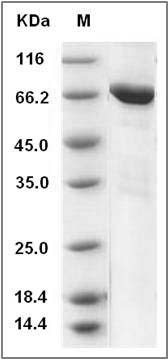-
Product Name
Mouse Tie2?CD202b?/TEK (aa 770-1122, His & GST Tag) recombinant protein
- Documents
-
Description
Tyrosine-protein kinase that acts as cell-surface receptor for ANGPT1, ANGPT2 and ANGPT4 and regulates angiogenesis, endothelial cell survival, proliferation, migration, adhesion and cell spreading, reorganization of the actin cytoskeleton, but also maintenance of vascular quiescence. Has anti-inflammatory effects by preventing the leakage of proinflammatory plasma proteins and leukocytes from blood vessels. Required for normal angiogenesis and heart development during embryogenesis. Required for post-natal hematopoiesis. After birth, activates or inhibits angiogenesis, depending on the context. Inhibits angiogenesis and promotes vascular stability in quiescent vessels, where endothelial cells have tight contacts. In quiescent vessels, ANGPT1 oligomers recruit TEK to cell-cell contacts, forming complexes with TEK molecules from adjoining cells, and this leads to preferential activation of phosphatidylinositol 3-kinase and the AKT1 signaling cascades. In migrating endothelial cells that lack cell-cell adhesions, ANGT1 recruits TEK to contacts with the extracellular matrix, leading to the formation of focal adhesion complexes, activation of PTK2/FAK and of the downstream kinases MAPK1/ERK2 and MAPK3/ERK1, and ultimately to the stimulation of sprouting angiogenesis. ANGPT1 signaling triggers receptor dimerization and autophosphorylation at specific tyrosine residues that then serve as binding sites for scaffold proteins and effectors. Signaling is modulated by ANGPT2 that has lower affinity for TEK, can promote TEK autophosphorylation in the absence of ANGPT1, but inhibits ANGPT1-mediated signaling by competing for the same binding site. Signaling is also modulated by formation of heterodimers with TIE1, and by proteolytic processing that gives rise to a soluble TEK extracellular domain. The soluble extracellular domain modulates signaling by functioning as decoy receptor for angiopoietins. TEK phosphorylates DOK2, GRB7, GRB14, PIK3R1, SHC1 and TIE1.
-
Protein name
Angiopoietin-1 receptor
-
Protein short names
AA517024; TIE-2; TIE2; CD202B; VMCM1; HYK; STK1; TEK; RP23-345A23.1; VMCM
-
Uniprot ID
Q02858
-
Gene Name
Tek; Hyk; Tie-2; Tie2
-
Source/Expression Host
Baculovirus-Insect Cells
-
Expression Plasmid/cDNA
A DNA sequence encoding the mouse TEK (Q02858) (Gln770-Ala1122) was fused with the N-terminal polyhistidine-tagged GST tag at the N-terminus.
-
Protein Species
Mouse
-
Molecular weight
The recombinant mouse TEK/GST chimera consists of 590 amino acids and has a calculated molecular mass of 68.2kDa. The recombinant protein migrates as an approximately 68 kDa band in SDS-PAGE under reducing conditions.
-
Purity
> 91 % as determined by SDS-PAGE
-
Activity
1. No Kinase Activity
2. Measured by its binding ability in a functional ELISA. Immobilized mouse TEK (aa 770-1122) (Cat: 500928) at 2 μg/ml (100 μl/well) can bind human Ang2-Fc (Cat: 503602) with a linear range of 0.25-2.0 μg/ml. -
Validations

Mouse Tie2 / TEK Protein (aa 770-1122, His & GST Tag) SDS-PAGE
Related Products / Services
Please note: All products are "FOR RESEARCH USE ONLY AND ARE NOT INTENDED FOR DIAGNOSTIC OR THERAPEUTIC USE"
